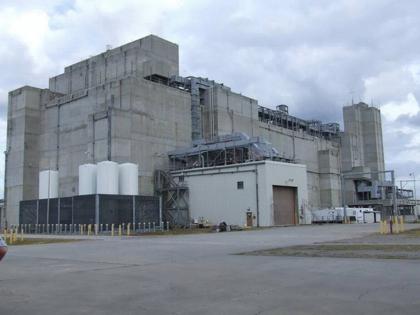Radioactive wasp nests spark demand for answers at South Carolina's Savannah River Site
Published in News & Features
COLUMBIA, S.C. — As word spreads about the discovery of radioactive wasp nests at a South Carolina nuclear weapons complex, some researchers and environmental activists are urging the government to provide more details about the finding.
So far, officials with the Savannah River Site have issued a basic statement saying that four different wasp nests were found on a post near a highly contaminated section of the property last month. But they have said there is no threat to the public. They’ve said wasps were lightly contaminated and were unlikely to spread toxins off the 310-square mile site.
Still, plenty of questions remain, including the types of radioactive material found in the nests, University of South Carolina biologist Tim Mousseau said.
“There’s insufficient information to really kind of determine the risks and the hazards,’’ said Mousseau, who has extensive experience studying the effects of radioactivity on plants and animals around the world.
Based on the SRS answers, for instance, it’s not clear whether the wasp nests were contaminated by a new leak at the weapons complex, he said. A new leak could indicate emerging contamination threats that need to be addressed. The nests were found in an area where large tanks store toxic nuclear material.
“If this reflects new leakage or new releases of pollutants that haven’t been documented, then this is a sentinel of potential issues related to the long-term storage of this nuclear waste, which is an ongoing issue at all … sites that were involved in and continue to be involved in the processing of materials mostly for national security purposes.’’ Mousseau said.
“So if this is indeed a sentinel … then we should be very concerned. This could be the beginning of a much larger problem.’’
Site officials said they believe the material is coming from “legacy’’ contamination, or places tainted long ago.
The discovery of the contaminated nests has created substantial interest by media outlets across the state and the nation, even though radioactive plants and animals have been documented on SRS for years. Among the outlets reporting on the wasps are The New York Times, the Washington Post, the BBC and CNN.
Previous reporting by The State has shown some animals with elevated levels of radioactivity, including turtles, fish and deer. The levels haven’t often been high enough to cause great concern. But during the past decade, the site has discovered radioactive bird droppings on an SRS roof, which is a concern because, unlike wasps, birds can travel great distances to areas away from the site where people live.
Tom Clements, who heads the watchdog group Savannah River Site Watch, acknowledged national interest in the wasps.
That’s why the government should provide more information, such as what kinds of radioactive materials were found in the nests and the exact contamination levels, he and Mousseau said.
Such information could help answer questions about whether wasp nests were tainted by current leaks or old contamination, they said.
Mousseau, whose studies have included the Chernobyl nuclear site in Ukraine, and Clements also said releasing the levels of contamination in the wasp nests would provide a better sense of whether the pollution is historic or has resulted from recent events.
Clements said he’s received recent correspondence indicating that some trees on the site have sustained radioactive contamination through the years. Some types of wasps use wood fiber to make nests.
The Savannah River Site, started in the 1950s near Aiken, is part of a group of facilities nationally that made material for atomic weapons. For years, SRS produced plutonium and tritium, and it still processes tritium. Today, it is again being considered as a site for ramped up atomic weapons production. A new plutonium pit factory is on the drawing boards.
Clements, a pit plant opponent who has closely tracked SRS issues since the 1980s, said radioactive leaks have occurred at the site’s tank farms in the past, although some of that was contained. Tanks in the farm contain dangerous radioactive waste. He said that some waste could leak when the toxic material inside them is piped out of the huge containers.
SRS is in the process of emptying the huge underground waste tanks as part of efforts to clean up the site, which is filled with areas polluted by atomic waste. The effort has been ongoing for decades.
Much of the work centers on piping the deadly waste to processing facilities, where much of the material is turned into glass to lower its threat. The glass is then stored on the SRS property.
An email from SRS, distributed to media since the discovery, says only that all of the nests were releasing less than 1% of the natural amount of radiation found in the environment. The email said it’s believed the pollution in the nests came from what is known as ‘’legacy contamination," or material that tainted the more than 70-year-old weapons site long ago.
Clements said that means nothing to him because much of the material in the waste tanks has been there for long periods, making it legacy waste.
“If it’s legacy contamination …. it’s old,’’ he said. “But it’s still a current threat potentially.’’
According to the SRS statement, workers discovered a radioactive nest on the F tank farm July 3 while conducting routine radiological monitoring. The nest was found on a post adjacent to waste tank 17, a federal report says. By July 31, they had found three more contaminated nests, SRS officials say.
Whether the types and levels of pollution will ever be fully known remains unclear. The SRS statement said workers sprayed the nests to kill the wasps “before radiological surveys could be taken.’’ But the release also said all of the wasps had “lower levels of contamination than the nests.’’
SRS says it has concluded that the nests became contaminated by wasps that brought tainted material to the nests. The bugs had apparently been in areas where legacy contamination is known to exist.
The SRS release conceded that the process of closing the waste tanks could potentially expose wasps and birds to low contamination levels, but it also said the public should not be alarmed.
“The U.S. Department of Energy is managing the discovery of four wasp nests with very low levels of radioactive contamination that have been found at the Savannah River Site (SRS),” according to a recent statement from Edwin Deshong, who runs SRS’s Office of Environmental Management. “The nests do not pose a health risk to SRS workers, the community, or the environment. Work will continue at the SRS where we are fully committed to ensuring the health and safety of the workers and the community.”
_____
©2025 The State. Visit thestate.com. Distributed by Tribune Content Agency, LLC.







Comments